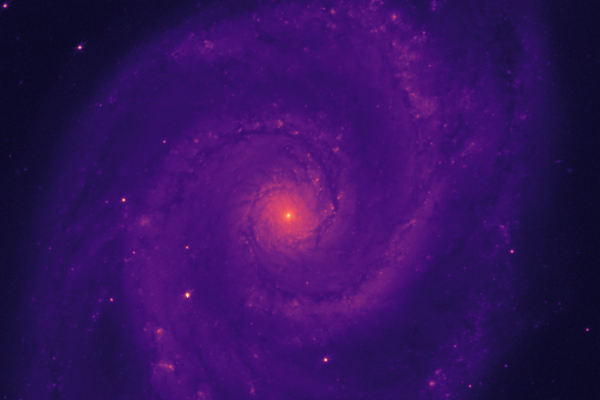Ohio State helps dark energy instrument's lenses see the night sky for the first time

On April 1 the dome of the Mayall Telescope near Tucson, Arizona, opened to the night sky, and starlight poured through the assembly of six large lenses that were carefully packaged and aligned for a new instrument that will launch later this year.
Just hours later, scientists produced the first focused images with these precision lenses — the largest is 1.1 meters in diameter — during this early test spin, marking an important “first light” milestone for the Dark Energy Spectroscopic Instrument, or DESI. This first batch of images homed in on the Whirlpool galaxy to demonstrate the quality of the new lenses.
DESI’s lenses are housed in a barrel-shaped device known as a corrector that is attached above the telescope’s primary mirror, and the corrector is moved and focused by a surrounding device known as a hexapod.
The precision testing of the corrector is made possible by an instrument — now mounted atop the telescope — that was designed and built by Ohio State researchers. This 1-ton device, which features five digital cameras and measuring tools supplied by Yale University, and electronics supplied by the University of Michigan, is known as the commissioning instrument.
The team of Ohio State researchers included Mark Derwent, lead engineer; Klaus Honscheid, head of the entire instrument control system for the DESI project; Paul Martini, leader of the R&D and installation of the instrument and currently overseeing its use; Ashley Ross, lead scientist and David Weinberg, co-lead of the DESI Bright Galaxy Survey.
This temporary instrument was built at the same weight and installed at the same spot where DESI’s focal plane will be installed once it is fully assembled. The focal plane will carry DESI’s robotic positioners. The commissioning instrument simulates how the telescope will perform when carrying the full complement of DESI components, and is verifying the quality of DESI’s lenses.
“One of the biggest challenges with the commissioning instrument was aligning all five cameras with the corrector's curved focal surface,” said Martini, professor of astronomy and faculty member at Ohio State’s Center for Cosmology and AstroParticle Physics, who led the R&D and installation of the commissioning instrument and is now overseeing its use. “Another was measuring their positions to a few millionths of a meter, which is far more precise than most astronomical instruments.” This positioning will ensure truer measurements of the lenses’ performance.
He said he is looking forward to the installation of DESI’s focal plane later this year. That will pave the way for DESI’s official “first light” of its robotic positioners and the start of its galaxy measurements.
“What got me excited about this field in the first place was going to telescopes and taking data, so it will be fun to have this next step,” he said.
When completed later this year, DESI will see and measure the sky’s light in a far different way with this assembly of lenses. The finished DESI will measure the light of tens of millions of galaxies reaching back 12 billion light-years across the universe. It is expected to provide the most precise measurement of the expansion of the universe and provide new insight into dark energy, which scientists expect is causing this expansion to accelerate.
The new set of lenses expands the telescope’s viewing window by about 16 times, enabling DESI to map about one-third of the visible sky several times during its five-year mission.
This success included the entire DESI group at Ohio State. The other members are Rebecca Coles, Ann Elliott, Kevin Fanning, Hui Kong, Tom O'Brien, Daniel Pappalardo, Jon Shover and Suk Sien Tie.
Read more about this project from the Berkeley Lab.
